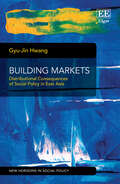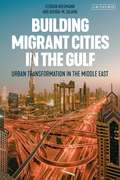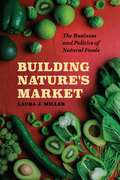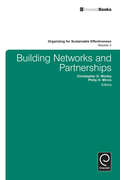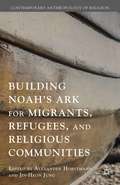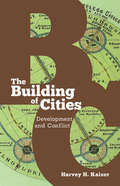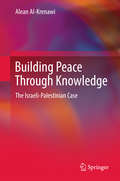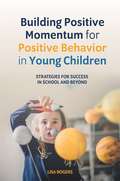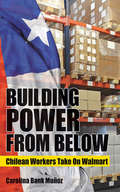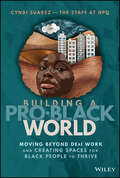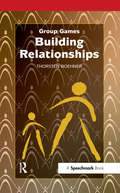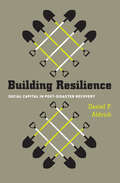- Table View
- List View
Building Markets: Distributional Consequences of Social Policy in East Asia (New Horizons in Social Policy series)
by Gyu-Jin HwangNowhere in the world presents a more dramatic case of wealth creation than East Asia. Contrary to the common belief that social policy in the economic powerhouses of the region is secondary to their pursuit of economic growth, Gyu-Jin Hwang argues that it has in fact played an integral part in building strong states and competitive market economies. Building Markets examines the original four Newly Industrialised Economies (NIEs) of East Asia: Hong Kong, Korea, Singapore, and Taiwan, as well as Japan, the regional forerunner in both economic and social terms. Chapters undertake a comparative analysis of the various social policy measures and redistributive efforts taken across a diverse range of social policy sectors in the region, covering cash transfers, healthcare, education, housing, and family policy. Addressing the mounting pressure on East Asian economies to rethink their growth strategies, Hwang concludes with a call for social means to be diverted, adapted, and converted to serve new social ends. Integrating cutting-edge theoretical insights with detailed policy analysis, Building Markets will be an invaluable tool for academics and postgraduate students interested in social policy, economics, and development in East Asia.
Building Migrant Cities in the Gulf: Urban Transformation in the Middle East
by Florian Wiedmann Ashraf M. SalamaHuman history has seen many settlements transformed or built entirely by expatriate work forces and foreigners arriving from various places. Recent migration patterns in the Gulf have led to emerging 'airport societies' on unprecedented scales. Most guest workers, both labourers and mid to high-income groups, perceive their stay as a temporary opportunity to earn suitable income or gain experience. This timely book analyses the essential characteristics of this unique urban phenomenon substantiated by concrete examples and empirical research. Both authors have lived and worked in the Gulf including Qatar, Bahrain and the United Arab Emirates during various periods between 2006 and 2014. They explore Gulf cities from macro and interconnected perspectives rather than focusing solely on singular aspects within the built environment. As academic architects specialised in urbanism and the complex dynamics between people and places the authors build new bridges for understanding demographic and social changes impacting urban transformations in the Gulf.
Building Migrant Cities in the Gulf: Urban Transformation in the Middle East
by Florian Wiedmann Ashraf M. SalamaHuman history has seen many settlements transformed or built entirely by expatriate work forces and foreigners arriving from various places. Recent migration patterns in the Gulf have led to emerging 'airport societies' on unprecedented scales. Most guest workers, both labourers and mid to high-income groups, perceive their stay as a temporary opportunity to earn suitable income or gain experience. This timely book analyses the essential characteristics of this unique urban phenomenon substantiated by concrete examples and empirical research. Both authors have lived and worked in the Gulf including Qatar, Bahrain and the United Arab Emirates during various periods between 2006 and 2014. They explore Gulf cities from macro and interconnected perspectives rather than focusing solely on singular aspects within the built environment. As academic architects specialised in urbanism and the complex dynamics between people and places the authors build new bridges for understanding demographic and social changes impacting urban transformations in the Gulf.
Building Nature's Market: The Business and Politics of Natural Foods
by Laura J. MillerFor the first 150 years of their existence, “natural foods” were consumed primarily by body builders, hippies, religious sects, and believers in nature cure. And those consumers were dismissed by the medical establishment and food producers as kooks, faddists, and dangerous quacks. In the 1980s, broader support for natural foods took hold and the past fifteen years have seen an explosion—everything from healthy-eating superstores to mainstream institutions like hospitals, schools, and workplace cafeterias advertising their fresh-from-the-garden ingredients. Building Nature’s Market shows how the meaning of natural foods was transformed as they changed from a culturally marginal, religiously inspired set of ideas and practices valorizing asceticism to a bohemian lifestyle to a mainstream consumer choice. Laura J. Miller argues that the key to understanding this transformation is to recognize the leadership of the natural foods industry. Rather than a simple tale of cooptation by market forces, Miller contends the participation of business interests encouraged the natural foods movement to be guided by a radical skepticism of established cultural authority. She challenges assumptions that private enterprise is always aligned with social elites, instead arguing that profit-minded entities can make common cause with and even lead citizens in advocating for broad-based social and cultural change.
Building Nature's Market: The Business and Politics of Natural Foods
by Laura J. MillerFor the first 150 years of their existence, “natural foods” were consumed primarily by body builders, hippies, religious sects, and believers in nature cure. And those consumers were dismissed by the medical establishment and food producers as kooks, faddists, and dangerous quacks. In the 1980s, broader support for natural foods took hold and the past fifteen years have seen an explosion—everything from healthy-eating superstores to mainstream institutions like hospitals, schools, and workplace cafeterias advertising their fresh-from-the-garden ingredients. Building Nature’s Market shows how the meaning of natural foods was transformed as they changed from a culturally marginal, religiously inspired set of ideas and practices valorizing asceticism to a bohemian lifestyle to a mainstream consumer choice. Laura J. Miller argues that the key to understanding this transformation is to recognize the leadership of the natural foods industry. Rather than a simple tale of cooptation by market forces, Miller contends the participation of business interests encouraged the natural foods movement to be guided by a radical skepticism of established cultural authority. She challenges assumptions that private enterprise is always aligned with social elites, instead arguing that profit-minded entities can make common cause with and even lead citizens in advocating for broad-based social and cultural change.
Building Nature's Market: The Business and Politics of Natural Foods
by Laura J. MillerFor the first 150 years of their existence, “natural foods” were consumed primarily by body builders, hippies, religious sects, and believers in nature cure. And those consumers were dismissed by the medical establishment and food producers as kooks, faddists, and dangerous quacks. In the 1980s, broader support for natural foods took hold and the past fifteen years have seen an explosion—everything from healthy-eating superstores to mainstream institutions like hospitals, schools, and workplace cafeterias advertising their fresh-from-the-garden ingredients. Building Nature’s Market shows how the meaning of natural foods was transformed as they changed from a culturally marginal, religiously inspired set of ideas and practices valorizing asceticism to a bohemian lifestyle to a mainstream consumer choice. Laura J. Miller argues that the key to understanding this transformation is to recognize the leadership of the natural foods industry. Rather than a simple tale of cooptation by market forces, Miller contends the participation of business interests encouraged the natural foods movement to be guided by a radical skepticism of established cultural authority. She challenges assumptions that private enterprise is always aligned with social elites, instead arguing that profit-minded entities can make common cause with and even lead citizens in advocating for broad-based social and cultural change.
Building Nature's Market: The Business and Politics of Natural Foods
by Laura J. MillerFor the first 150 years of their existence, “natural foods” were consumed primarily by body builders, hippies, religious sects, and believers in nature cure. And those consumers were dismissed by the medical establishment and food producers as kooks, faddists, and dangerous quacks. In the 1980s, broader support for natural foods took hold and the past fifteen years have seen an explosion—everything from healthy-eating superstores to mainstream institutions like hospitals, schools, and workplace cafeterias advertising their fresh-from-the-garden ingredients. Building Nature’s Market shows how the meaning of natural foods was transformed as they changed from a culturally marginal, religiously inspired set of ideas and practices valorizing asceticism to a bohemian lifestyle to a mainstream consumer choice. Laura J. Miller argues that the key to understanding this transformation is to recognize the leadership of the natural foods industry. Rather than a simple tale of cooptation by market forces, Miller contends the participation of business interests encouraged the natural foods movement to be guided by a radical skepticism of established cultural authority. She challenges assumptions that private enterprise is always aligned with social elites, instead arguing that profit-minded entities can make common cause with and even lead citizens in advocating for broad-based social and cultural change.
Building Nature's Market: The Business and Politics of Natural Foods
by Laura J. MillerFor the first 150 years of their existence, “natural foods” were consumed primarily by body builders, hippies, religious sects, and believers in nature cure. And those consumers were dismissed by the medical establishment and food producers as kooks, faddists, and dangerous quacks. In the 1980s, broader support for natural foods took hold and the past fifteen years have seen an explosion—everything from healthy-eating superstores to mainstream institutions like hospitals, schools, and workplace cafeterias advertising their fresh-from-the-garden ingredients. Building Nature’s Market shows how the meaning of natural foods was transformed as they changed from a culturally marginal, religiously inspired set of ideas and practices valorizing asceticism to a bohemian lifestyle to a mainstream consumer choice. Laura J. Miller argues that the key to understanding this transformation is to recognize the leadership of the natural foods industry. Rather than a simple tale of cooptation by market forces, Miller contends the participation of business interests encouraged the natural foods movement to be guided by a radical skepticism of established cultural authority. She challenges assumptions that private enterprise is always aligned with social elites, instead arguing that profit-minded entities can make common cause with and even lead citizens in advocating for broad-based social and cultural change.
Building Nature's Market: The Business and Politics of Natural Foods
by Laura J. MillerFor the first 150 years of their existence, “natural foods” were consumed primarily by body builders, hippies, religious sects, and believers in nature cure. And those consumers were dismissed by the medical establishment and food producers as kooks, faddists, and dangerous quacks. In the 1980s, broader support for natural foods took hold and the past fifteen years have seen an explosion—everything from healthy-eating superstores to mainstream institutions like hospitals, schools, and workplace cafeterias advertising their fresh-from-the-garden ingredients. Building Nature’s Market shows how the meaning of natural foods was transformed as they changed from a culturally marginal, religiously inspired set of ideas and practices valorizing asceticism to a bohemian lifestyle to a mainstream consumer choice. Laura J. Miller argues that the key to understanding this transformation is to recognize the leadership of the natural foods industry. Rather than a simple tale of cooptation by market forces, Miller contends the participation of business interests encouraged the natural foods movement to be guided by a radical skepticism of established cultural authority. She challenges assumptions that private enterprise is always aligned with social elites, instead arguing that profit-minded entities can make common cause with and even lead citizens in advocating for broad-based social and cultural change.
Building Networks and Partnerships (Organizing for Sustainable Effectiveness #3)
by Philip H. Mirvis Abraham B. ShaniOrganizing for Sustainable Effectiveness highlights research and practice aimed at understanding how organizations and more inclusive systems of actors develop a continuous, unfaltering focus on sustainability. It will examine how they organize to achieve expanded purposes, the associated changes in purpose and governance, relationships among various stakeholders, boundaries between organizations and other elements of the environment in which they operate, organizational systems and processes, leadership, competencies and capabilities. Thus 'sustainability' is seen as entailing a continuous dynamic adaptive process in people, organizations and systems, striving to be as proactive as possible, moving 'upstream' in improving and developing organizational processes and issues.
Building Noah’s Ark for Migrants, Refugees, and Religious Communities (Contemporary Anthropology of Religion)
by Jin-Heon JungBuilding Noah's Ark for Migrants, Refugees, and Religious Communities examines religion within the framework of refugee studies as a public good, with the spiritual and material use of religion shedding new light on the agency of refugees in reconstructing their lives and positioning themselves in hostile environments.
The Building of Cities: Development and Conflict
by Harvey H. KaiserIn this classic book that records a moment in the history of urban planning, the architect and city planner Harvey H. Kaiser examines the city-building process from the time when a proposal for urban development is first conceived to the early stages of construction. Lysander (near Syracuse) and Gananda and Riverton (both near Rochester). These were brand-new developments and municipalities, and thus quite different from other trends of suburbanization that attached development onto existing municipalities. Step by step, he describes what happened in each of these communities during the presentation of the initial proposal, how parties interacted with each other, and how the climate of the community influenced the actions of the parties. Basing his work on hundreds of interviews, attendance at public meetings, and a review of many articles and documents, Kaiser shows that in each case the emergence of controversy and degree of acceptance was influenced by the developer's leadership, the characteristics of the developer's organization, and the method of presenting the proposal to the public. Kaiser brings to his comparative approach a background in the rough and tumble of day-to-day project management and the development of plans as well as their administration. The Building of Cities is an invaluable resource for developers, architects, public officials, and citizens involved in local government.
Building Peace Through Knowledge: The Israeli-Palestinian Case
by Alean Al-KrenawiThis groundbreaking volume documents a comprehensive peacebuilding initiative in addressing the Israeli-Palestinian conflict and reviews the broad theoretical base underlying these efforts. Theory chapters discuss intrinsic peace-related concepts, including the nature of conflict, elements of individual and group identity, the long-term psychological effects of prolonged political hostilities, and the mechanisms of reconciliation and inclusiveness. Central to the coverage is the ambitious Building Peace through Knowledge Project, a four-year multidisciplinary program featuring a diverse palette of professional and community interventions to reduce the occurrence and trauma of political violence. The author reveals powerful insights connecting knowledge to peacebuilding by analyzing: · The relationships between attitudes and ideology in intergroup conflict. · The psychosocial impact of political violence among Israelis and Palestinians. · The literature on people-to-people interventions (P2Ps) in conflict reduction. · The roles of forgiveness, reconciliation, and fairness in conflict resolution. · The methodology and findings of the Building Peace through Knowledge Project. · The potential of knowledge-based interventions in building sustainable peace in other regions. Practitioners, mental health professionals, and scholars with interests in multicultural mental health, cross-cultural psychology, political violence, and peace education will look to Building Peace through Knowledge as an ideabook, a mission statement, and a road map toward a more stable world.
Building Positive Momentum for Positive Behavior in Young Children: Strategies for Success in School and Beyond
by Lisa RogersProviding practical solutions to common behavioral problems, this book shows how to use the positive momentum approach to encourage long-term positive behaviour among children aged 3-9. Covering issues such as what to do when a child avoids doing work, when they engage in rough play, and when they won't stay in their seat, this book includes targeted behavioral strategies that start with the underlying foundations of behaviour and result in lasting positive change. Through real life examples, the book shows how educators can be role models for children, and how school staff can collaborate with families for success beyond the classroom. The book also includes information specific to working with children with special needs. Accompanying behaviour charts and goal mapping resources are available to download to help with tracking a child's progress.
Building Positive Momentum for Positive Behavior in Young Children: Strategies for Success in School and Beyond (PDF)
by Lisa RogersProviding practical solutions to common behavioral problems, this book shows how to use the positive momentum approach to encourage long-term positive behaviour among children aged 3-9. Covering issues such as what to do when a child avoids doing work, when they engage in rough play, and when they won't stay in their seat, this book includes targeted behavioral strategies that start with the underlying foundations of behaviour and result in lasting positive change. Through real life examples, the book shows how educators can be role models for children, and how school staff can collaborate with families for success beyond the classroom. The book also includes information specific to working with children with special needs. Accompanying behaviour charts and goal mapping resources are available to download to help with tracking a child's progress.
Building Power from Below: Chilean Workers Take On Walmart
by Carolina Bank MuñozA story that involves as its main players "workers" and "Walmart" does not usually have a happy ending for labor, so the counternarrative offered by Building Power from Below is must reading for activists and union personnel as well as scholars. In 2008 Walmart acquired a controlling share in a large supermarket chain in Santiago, Chile. As part of the deal Walmart had to accept the unions that were already in place. Since then, Chilean retail and warehouse workers have done something that has seemed impossible for labor in the United States: they have organized even more successful unions and negotiated unprecedented contracts with Walmart.In Building Power from Below, Carolina Bank Muñoz attributes Chilean workers’ success in challenging the world’s largest corporation to their organizations’ commitment to union democracy and building strategic capacity. Chilean workers have spent years building grassroots organizations committed to principles of union democracy. Retail workers’ unions have less structural power, but have significant associational and symbolic power. Their most notable successes have been in fighting for respect and dignity on the job. Warehouse workers by contrast have substantial structural power and have achieved significant economic gains. While the model in Chile cannot necessarily be reproduced in different countries, we can gain insights from the Chilean workers’ approaches, tactics, and strategies.
Building A Pro-Black World: Moving Beyond DE&I Work and Creating Spaces for Black People to Thrive
by Nonprofit QuarterlyLearn to create a nonprofit organization and society in which Black people can thrive In Building A Pro-Black World: A Guide To Creating True Equity in The Workplace and In Life, a team of dedicated nonprofit leaders delivers a timely roadmap to building pro-Black nonprofit organizations. Refreshingly moving the conversation beyond stale DEI cliches, editors Cyndi Suarez and the NPQ staff have included works from leading racial justice voices that show you how to create an environment—and society—in which Black people can thrive. You’ll also learn how building such a world will benefit all of society, from the most marginalized to the least. The book explains how to shift from simply critiquing white supremacist culture and calling out anti-Blackness to actively designing for pro-Blackness. It offers you: Incisive and engaging work from leading voices in racial justice, Cyndi Suarez, Dax-Devlon Ross, Liz Derias, Kad Smith, and Isabelle Moses Explorations of topics ranging from restorative leadership strategies for staff wellbeing to Black politics and policymaking Discussions of new language for pro-Black social change, racial equity in healthcare and health communications, and antiracist succession planning A can’t-miss resource for civil society and nonprofit leaders, including directors, executives, grant makers, philanthropic donors, and social movement leaders, Building Pro-Black World will also benefit communicators, organizers, and consultants who work with nonprofit organizations.
Building A Pro-Black World: Moving Beyond DE&I Work and Creating Spaces for Black People to Thrive
by Nonprofit QuarterlyLearn to create a nonprofit organization and society in which Black people can thrive In Building A Pro-Black World: A Guide To Creating True Equity in The Workplace and In Life, a team of dedicated nonprofit leaders delivers a timely roadmap to building pro-Black nonprofit organizations. Refreshingly moving the conversation beyond stale DEI cliches, editors Cyndi Suarez and the NPQ staff have included works from leading racial justice voices that show you how to create an environment—and society—in which Black people can thrive. You’ll also learn how building such a world will benefit all of society, from the most marginalized to the least. The book explains how to shift from simply critiquing white supremacist culture and calling out anti-Blackness to actively designing for pro-Blackness. It offers you: Incisive and engaging work from leading voices in racial justice, Cyndi Suarez, Dax-Devlon Ross, Liz Derias, Kad Smith, and Isabelle Moses Explorations of topics ranging from restorative leadership strategies for staff wellbeing to Black politics and policymaking Discussions of new language for pro-Black social change, racial equity in healthcare and health communications, and antiracist succession planning A can’t-miss resource for civil society and nonprofit leaders, including directors, executives, grant makers, philanthropic donors, and social movement leaders, Building Pro-Black World will also benefit communicators, organizers, and consultants who work with nonprofit organizations.
Building Relationships (Group Games)
by Thorsten Boehner Lilo SeelosGroup Games: Building Relationships Thorsten Boehner - A comprehensive collection of 140 games and activities to foster personal development; improve social communication skills; and strengthen group dynamics. Full of practical and creative ideas that can be implemented with minimal preparation and equipment. 140 games and activities to foster personal development; improve social communication skills; and strengthen group dynamics. Full of practical and creative ideas that can be implemented with minimal preparation and equipment. Suitable for all ages, the games will increase self- and other-awareness; improve recognition of one's own limits as well as awareness of the limits of others; encourage better teamwork skills; and increase flexibility as participants gain new experiences in a playful and safe environment. Includes: Group gel activities; Warm-up activities; Exercises for building trust and awareness; Imagination and improvisation; Closing exercises; Special exercises and tips for amateur dramatics lovers.
Building Relationships (Group Games)
by Thorsten Boehner Lilo SeelosGroup Games: Building Relationships Thorsten Boehner - A comprehensive collection of 140 games and activities to foster personal development; improve social communication skills; and strengthen group dynamics. Full of practical and creative ideas that can be implemented with minimal preparation and equipment. 140 games and activities to foster personal development; improve social communication skills; and strengthen group dynamics. Full of practical and creative ideas that can be implemented with minimal preparation and equipment. Suitable for all ages, the games will increase self- and other-awareness; improve recognition of one's own limits as well as awareness of the limits of others; encourage better teamwork skills; and increase flexibility as participants gain new experiences in a playful and safe environment. Includes: Group gel activities; Warm-up activities; Exercises for building trust and awareness; Imagination and improvisation; Closing exercises; Special exercises and tips for amateur dramatics lovers.
Building Resilience: Social Capital in Post-Disaster Recovery
by Daniel P. AldrichEach year, natural disasters threaten the strength and stability of communities worldwide. Yet responses to the challenges of recovery vary greatly and in ways that aren’t explained by the magnitude of the catastrophe or the amount of aid provided by national governments or the international community. The difference between resilience and disrepair, as Daniel P. Aldrich shows, lies in the depth of communities’ social capital. Building Resilience highlights the critical role of social capital in the ability of a community to withstand disaster and rebuild both the infrastructure and the ties that are at the foundation of any community. Aldrich examines the post-disaster responses of four distinct communities—Tokyo following the 1923 earthquake, Kobe after the 1995 earthquake, Tamil Nadu after the 2004 Indian Ocean Tsunami, and New Orleans post-Katrina—and finds that those with robust social networks were better able to coordinate recovery. In addition to quickly disseminating information and financial and physical assistance, communities with an abundance of social capital were able to minimize the migration of people and valuable resources out of the area. With governments increasingly overstretched and natural disasters likely to increase in frequency and intensity, a thorough understanding of what contributes to efficient reconstruction is more important than ever. Building Resilience underscores a critical component of an effective response.
Building Resilience: Social Capital in Post-Disaster Recovery
by Daniel P. AldrichEach year, natural disasters threaten the strength and stability of communities worldwide. Yet responses to the challenges of recovery vary greatly and in ways that aren’t explained by the magnitude of the catastrophe or the amount of aid provided by national governments or the international community. The difference between resilience and disrepair, as Daniel P. Aldrich shows, lies in the depth of communities’ social capital. Building Resilience highlights the critical role of social capital in the ability of a community to withstand disaster and rebuild both the infrastructure and the ties that are at the foundation of any community. Aldrich examines the post-disaster responses of four distinct communities—Tokyo following the 1923 earthquake, Kobe after the 1995 earthquake, Tamil Nadu after the 2004 Indian Ocean Tsunami, and New Orleans post-Katrina—and finds that those with robust social networks were better able to coordinate recovery. In addition to quickly disseminating information and financial and physical assistance, communities with an abundance of social capital were able to minimize the migration of people and valuable resources out of the area. With governments increasingly overstretched and natural disasters likely to increase in frequency and intensity, a thorough understanding of what contributes to efficient reconstruction is more important than ever. Building Resilience underscores a critical component of an effective response.
Building Resilience: Social Capital in Post-Disaster Recovery
by Daniel P. AldrichEach year, natural disasters threaten the strength and stability of communities worldwide. Yet responses to the challenges of recovery vary greatly and in ways that aren’t explained by the magnitude of the catastrophe or the amount of aid provided by national governments or the international community. The difference between resilience and disrepair, as Daniel P. Aldrich shows, lies in the depth of communities’ social capital. Building Resilience highlights the critical role of social capital in the ability of a community to withstand disaster and rebuild both the infrastructure and the ties that are at the foundation of any community. Aldrich examines the post-disaster responses of four distinct communities—Tokyo following the 1923 earthquake, Kobe after the 1995 earthquake, Tamil Nadu after the 2004 Indian Ocean Tsunami, and New Orleans post-Katrina—and finds that those with robust social networks were better able to coordinate recovery. In addition to quickly disseminating information and financial and physical assistance, communities with an abundance of social capital were able to minimize the migration of people and valuable resources out of the area. With governments increasingly overstretched and natural disasters likely to increase in frequency and intensity, a thorough understanding of what contributes to efficient reconstruction is more important than ever. Building Resilience underscores a critical component of an effective response.
Building Resilience: Social Capital in Post-Disaster Recovery
by Daniel P. AldrichEach year, natural disasters threaten the strength and stability of communities worldwide. Yet responses to the challenges of recovery vary greatly and in ways that aren’t explained by the magnitude of the catastrophe or the amount of aid provided by national governments or the international community. The difference between resilience and disrepair, as Daniel P. Aldrich shows, lies in the depth of communities’ social capital. Building Resilience highlights the critical role of social capital in the ability of a community to withstand disaster and rebuild both the infrastructure and the ties that are at the foundation of any community. Aldrich examines the post-disaster responses of four distinct communities—Tokyo following the 1923 earthquake, Kobe after the 1995 earthquake, Tamil Nadu after the 2004 Indian Ocean Tsunami, and New Orleans post-Katrina—and finds that those with robust social networks were better able to coordinate recovery. In addition to quickly disseminating information and financial and physical assistance, communities with an abundance of social capital were able to minimize the migration of people and valuable resources out of the area. With governments increasingly overstretched and natural disasters likely to increase in frequency and intensity, a thorough understanding of what contributes to efficient reconstruction is more important than ever. Building Resilience underscores a critical component of an effective response.
Building Resilience: Social Capital in Post-Disaster Recovery
by Daniel P. AldrichEach year, natural disasters threaten the strength and stability of communities worldwide. Yet responses to the challenges of recovery vary greatly and in ways that aren’t explained by the magnitude of the catastrophe or the amount of aid provided by national governments or the international community. The difference between resilience and disrepair, as Daniel P. Aldrich shows, lies in the depth of communities’ social capital. Building Resilience highlights the critical role of social capital in the ability of a community to withstand disaster and rebuild both the infrastructure and the ties that are at the foundation of any community. Aldrich examines the post-disaster responses of four distinct communities—Tokyo following the 1923 earthquake, Kobe after the 1995 earthquake, Tamil Nadu after the 2004 Indian Ocean Tsunami, and New Orleans post-Katrina—and finds that those with robust social networks were better able to coordinate recovery. In addition to quickly disseminating information and financial and physical assistance, communities with an abundance of social capital were able to minimize the migration of people and valuable resources out of the area. With governments increasingly overstretched and natural disasters likely to increase in frequency and intensity, a thorough understanding of what contributes to efficient reconstruction is more important than ever. Building Resilience underscores a critical component of an effective response.
